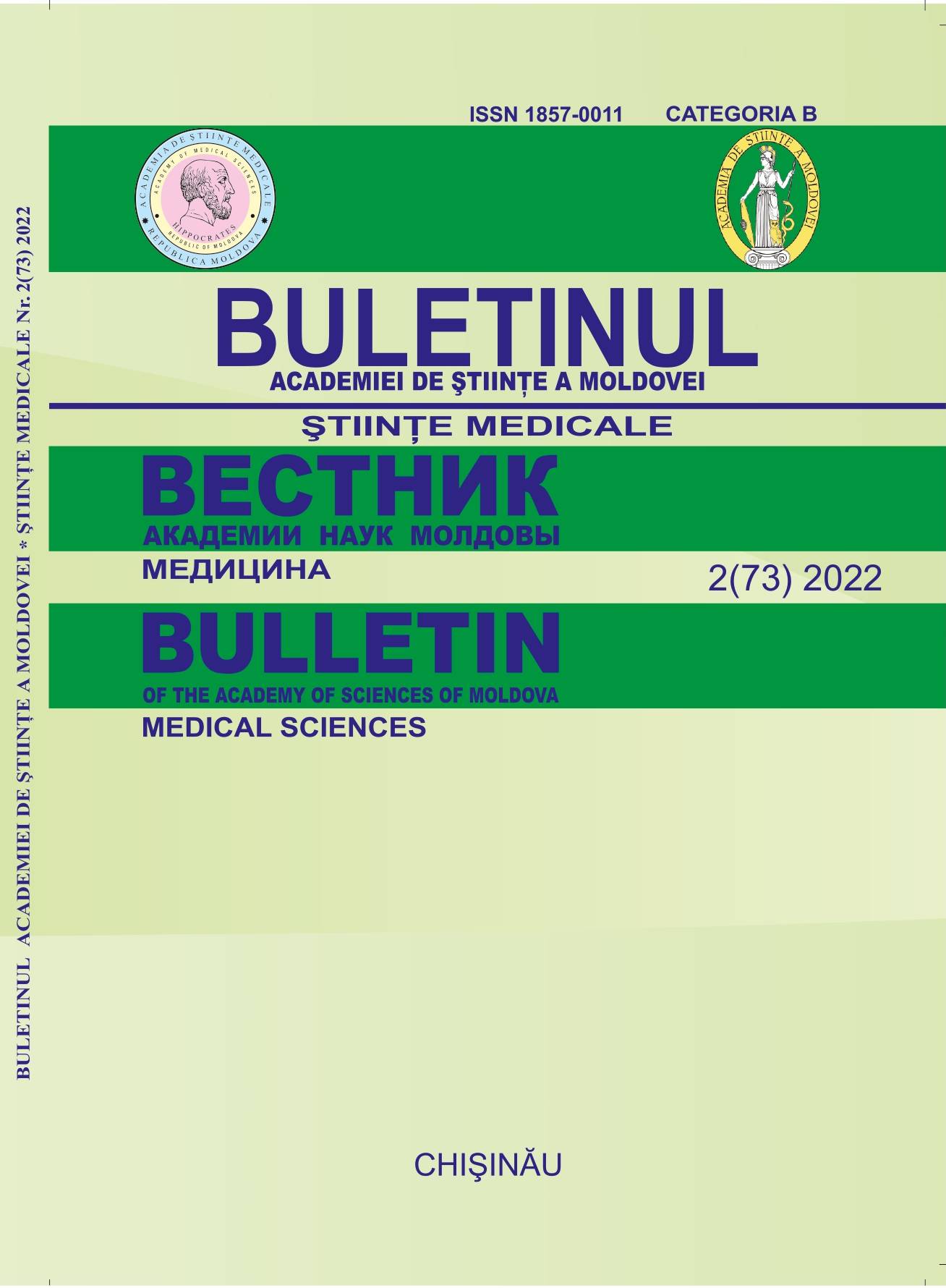IMPACTUL FACTORULUI DE NECROZĂ TUMORALĂ-Α ASUPRA AFECTĂRII PRIN CARIE DENTARĂ A COPIILOR CU TUMORI MALIGNE
DOI:
https://doi.org/10.52692/1857-0011.2022.2-73.13Cuvinte cheie:
carie dentară, TNF-α, fluid oral, tumori maligne, radioterapieRezumat
Scopul prezentului studiu a fost studierea impactului nivelului Factorului de Necroză Tumorală-α (TNF-α) asupra afectării prin carie dentară a copiilor cu tumori maligne după administrarea radioterapiei în regiunea capului și gâtului. În studiul de tip caz-martor au fost incluși 48 de copii cu vârste cuprinse între 1 și18 ani repartizați în 2 loturi identice după structură. Lotul de cercetare (L1) a fost constituit din 24 de copii cu tu mori maligne în regiunea capului și gâtului la distanța de 6 luni - 2 ani după finalizarea administrării radioterapiei (RT). În lotul martor (L0) au fost incluși 24 de copii convenţional sănătoși. S-au studiat indicii de experiență carioasă. Predicţia cariei dentare (CD) și evaluarea complexă a riscului carios a fost efectuată cu aplicarea Software Cariogram. TNF-α în fluidul oral (FO) şi serul sangvin a fost apreciat prin metoda de analiză imunoenzimatică pe suport solid. Analiza rezultatelor studiului a elucidat nivelul crescut al TNF-α, în FO (de 5,53 ori) și serul sangvin (de 10,19 ori) al copiilor cu tumori maligne după finalizarea RT, comparativ cu subiecții sănătoși.Concluzii. Aprecierea nivelului TNF-α în fluidul oral şi serul sangvin, în complex cu alte metode de prognostic a cari- ei dentare, este o metodă informativă și importantă în predicția timpurie a CD și gradului intens de activitate a procesului carios, necesare pentru corecția măsurilor preventive și de tratament al CD.
Referințe
Plan național de combatere a cancerului. București, 2022, 102 p. Disponibil la: https://www.ms.ro
Agenția Internațională de Cercetare a Cancerului. Planul european de combatere a cancerului, Comisia pentru resurse naturale. Bruxelles, 2021, disponibil la: https://ec.europa.eu/health/sites/default/files/non_communicable_diseases/docs/eu_cancer-plan_en.pdf
Europe’s Beating Cancer Plan Communication from the commission to the European Parliament and the Council. Bruxelles, 2021. Disponibil la: https://eu_cancer-plan_en_0.pdf (europa.eu)
GLOBOCAN 2020. Disponibil la: https://www.uicc.org/news/globocan-2020-new-global-cancer-data
Report of a WHO Expert Committee. WHO Technical Report Series, nr. 782, 2020.
Țîbîrnă Gh., et al. Epidemiologia tumorilor benigne și maligne la copii în Republica Moldova (1 an de activitate-2020). Buletinul Academiei de Ştiinţe a Moldovei. Ştiinţe Medicale, 2021; 2(70): 8-23.
Grejdeanu T., Voloceai V. Calitatea vieţii pacienţilor cu cancer. Anale Ştiințifice ale USMF “Nicolae Testemiţanu”, Probleme actuale desănătate publică şi management, Chișinău: CEP Medicina, 2011; 12(2):205-208.
National Comprehensive Cancer Network NCCN clinical practice guideline in oncology (NCCN guidelines) head and neck cancers. Disponibil la: https://www.nccn.org/professionals/physician_gls/default.aspx#site.
Gouvêa Vasconcellos AF., et. al. Impact of Clustering Oral Symptoms in the Pathogenesis of Radiation Caries: A Systematic Review. Caries Res, 2020; 54(2):113-126. doi: 10.1159/000504878. Epub 2020 Jan 21. PMID: 31962337.
Gupta N., Pal M., Rawat S., et al. Radiation-induced dental caries, prevention and treatment A systematic review. Natl J Maxillofac Surg, 2015; 6:160-6. 10.4103/0975-5950.183870.
Rangel Palmier N., et. al. Radiation-related caries assessment through the International Caries Detection and Assessment System and the Post-Radiation Dental Index. Oral Surgery, Oral Medicine, Oral Pathology and Oral Radiology. 2017, 124(4), 542-547.
Michelet M. Caries and periodontal disease in cancer survivors. Evid Based Dent, 2012; 13:70-73. https://doi.org/10.1038/sj.ebd.6400870
Dobroś K., Hajto-Bryk J., Wróblewska M., Zarzecka J. Radiation-induced caries as the late effect of radiation therapy in the head and neck region. Contemp Oncol (Pozn), 2016; 20(4):287-90. doi: 10.5114/wo.2015.54081.
Lu H., Zha, Q., Guo, J. et al. Direct radiation-induced effects on dental hard tissue. Radiat Oncol, 2019; 14(5). https://doi.org/10.1186/s13014-019-1208-1
Aguiar G.P., Jham B.C., Magalhães C.S., Sensi L.G., Freire A.R. A review of the biological and clinical aspects of radiation caries. J. Contemp. Dent. Pract, 2009; 10:83–89.
Lieshout H.F., Bots C. P. The effect of radiotherapy on dental hard tissue–a systematic review. Clin. Oral Investig, 2014; 18:17-24. https://doi.org/10.1007/s00784013-1034-z.
Silva A.R., Alves F.A., Berger S.B., Giannini M., Goes M.F., Lopes M.A. 2010. Radiation‐related caries and early restoration failure in head and neck cancer patients. A polarized light microscopy and scanning electron microscopy study. Support. Care Cancer, 2010; 18:83-87. https://doi.org/10.1007/s00520-009-0633-3.
Al‐Nawas, B., Grötz K.A. Prospective study of the long term change of the oral flora after radiation therapy. Support. Care Cancer, 2006; 14:291-296.
Escoda‐Francolí, J., Rodríguez‐Rodríguez A., Pérez‐García S., Gargallo‐Albiol J., and Gay‐Escoda C.. 2011. Dental implications in oral cancer patients. Med. Oral Patol. Oral Cir. Bucal, 2011; 16(4):e508-13. doi: 10.4317/medoral.16.e508.16:e508–e513.
Sroussi HY., et al. Common oral complications of head and neck cancer radiation therapy: mucositis, infections, saliva change, fibrosis, sensory dysfunctions, dental caries, periodontal disease, and osteoradionecrosis. Cancer Me, 2017; 12(6): 2918-2931.
Hey J., Seidel J., Schweyen R. et al. The influence of parotid gland sparing on radiation damages of dental hard tissues. Clin Oral Invest, 2013; 17:1619-1625. https://doi.org/10.1007/s00784-012-0854-6
Nandan GD., Kulkarni PG. Salivary Tumour Necrosis Factor-α as a Biomarker in Oral Leukoplakia and Oral Squamous Cell Carcinoma. Asian Pac J Cancer Prev, 2019; 20(7): 2087-2093. doi: 10.31557/APJCP.2019.20.7.2087.
Roșu MC., Mihnea PD., Ardelean A., Moldovan SD., Popețiu RO., Totolici BD. Clinical significance of tumor necrosis factor-alpha and carcinoembryonic antigen in gastric cancer. J Med Life, 2022; 15(1):4-6. doi: 10.25122/jml-2020-0098. PMID: 35186129.
Oral health surveys: basic methods 5th edition World Health Organization. WHO Library Cataloguing-in-Publication Data; 2013, 125 p.
Godoroja P, Spinei A, Spinei Iu. Stomatologie terapeutică pediatrică. Centrul Editorial-Poligrafic Medicina, Chişinău; 2003, 338 p.
Леус П.А., Деньга О.В., Кабаев А.А., Кисельникова Л.П., Манрикян М.Е.. Нарыкова А.А., Омельченко А.В., Смоляр Н.И., Спиней А.Ф., Хамадеева А.М. Европейские индикаторы стоматологического здоровья детей школьного возраста. Стоматология детского возраста. 2013; 3:3-9.
Bratthall D. Cariogram multifactorial risk assessment model for multifactorial disease. În: Community Dent Oral Epidemiol, 2005; 33:256-264.
Prso I.B., Kocjan W., Šimić H., et al. Tumor Necrosis Factor-Alpha and Interleukin 6 in Human Periapical Lesions. În: Mediators of Inflammation, 2007: Article ID 38210, 4 p., doi:10.1155/2007/38210
Silva T.A., Garlet G.P., Lara V.S., Martins W., Jr, Silva J.S., Cunha F.Q. Differential expression of chemokines and chemokine receptors in inflammatory periapical diseases. În: Oral Microbiology and Immunology, 2005; 20(5): 310-316.
Cogulu D., Onay H., Ozdemir Y., Aslan G.I., Ozkinay F., Kutukculer N., Eronat C. Associations of interleukin (IL)-1β, IL-1 receptor antagonist, and IL-10 with dental caries. În: Journal of Oral Science, 2015; 57(1):31-36.
Gornowicz A., Bielawska A., Bielawski K., Grabowska S.Z., Wojcicka A., Zalewska M. et al. Pro-inflammatory cytokines in saliva of adolescents with dental caries disease. Ann Agric Environ Med, 2012; 219: 711-716.
Hahn C.L., Best A.M., Tew J.G. Comparison of type 1 and type 2 cytokine production by mononuclear cells cultured with Streptococcus mutans and selected other caries bacteria. În: J Endod, 2004; 30: 333-338.
Hirschfeld J., Dommisch H., Skora P., et.al. Neutrophil extracellular trap formation in supragingival biofilms. Int J Med Microbiol, 2015; 305(4-5):453-463.
Spinei A. Impact of cytokine profile on dental caries morbidity in children with severe diseases of the central nervous system. În: Romanian Journal of Dental Medicine, 2016; nr. 19(3): 166-190.
Balto K., Sasaki H., Stashenko P. Interleukin-6 deficiency increases inflammatory bone destruction. Infection and Immunity, 2001; 69(2):744-750.
Keller J.F., Carrouel F., Colomb E., et.al. Toll-like receptor 2 activation by lipoteichoic acid induces differential production of pro-inflammatory cytokines in human odontoblasts, dental pulp fibroblasts and immature dendritic cells. Immunobiology, 2010; 215:53-59. doi: 10.1016/j. imbio.2009.01.009.
Симбирцев A. Достижения и перспективы использования рекомбинантных цитокинов в клинической практике. Медицинский академический журнал, 2013; 13 (1):7-22.
Милехина C. Состояние локального иммунитета и фосфорно-кальциевого обмена у детей с кариесом. Автореферат диссертации на соискание ученой степени кандидата медицинских наук. Владивосток, 2012, 23 p.
Teiji Wada T., Nakashima T., Hiroshi N., Penninger J.M., RANKL–RANK signaling in osteoclastogenesis and bone disease. Trends in Molecular Medicine, 2006, 12(1): 17-25.
Vernal R., Dezerega A., Dutzan N., et al. RANKL in human periapical granuloma: possible involvement in periapical bone destruction. Oral Diseases, 2006; 12(3):283-289.
Descărcări
Publicat
Număr
Secțiune
Licență
Copyright (c) 2022 Buletinul Academiei de Științe a Moldovei. Științe medicale

Această lucrare este licențiată în temeiul Creative Commons Attribution 4.0 International License.



